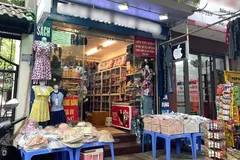
The Mekong Delta offers a smooth link with other intra-regional and inter-regional areas. Hence, it is imperative to invest and develop a strong network of traffic infrastructure in the Mekong Delta region.
Projects such as wide roads, waterways, maritime and air traffic systems, arterial longitudinal axis, horizontal roads, Eastern and Western coastal ring roads, new axis South of Hậu River and in Quản Lộ - Phụng Hiệp, along with Route N1, Route N2 and sections of expressways are all part of new investments in the Mekong Delta. The large river-crossing bridges such as Mỹ Thuận, Cần Thơ, Rạch Miễu, Vàm Cống, Cao Lãnh, Đầm Cùng, and Năm Căn that connect the green river banks, will all serve the traffic needs of the land of the Nine Dragons. Along with these projects, new construction projects such as the Phú Quốc International Airport, upgrade of the Cần Thơ
International Airport, and investment in seaports in seaport cluster 6, will create a vibrant means of communication in the Mekong Delta Region.
Since the end of 2020 until now, there has been continuous good news related to planning, medium and long-term plans, new investment policies, more allocating of capital, and the start of key traffic works in the West. The Trung Lương-Mỹ Thuận Expressway is already on the finish line, and construction of the Mỹ Thuận-Cần Thơ Expressway will start soon which will cover 830 kms of expressway by 2025.
According to regional planning, the expressway system of strategic significance is the Cần Thơ-Cà Mau, and Châu Đốc-Cần Thơ-Trần Đề in Sóc Trăng, which covers about 400 kms. This project will be prioritized for investment in the period upto 2025 to create a new highway backbone. Looking at the road, waterway, maritime, and aviation plans of the whole country, integrated with the development plan of the Mekong Delta region, the regional traffic will be much more robust and effective.
New bridge projects across the river such as the Mỹ Thuận 2 bridge, Rạch Miễu 2 bridge, Châu Đốc bridge, which is the 3rd bridge connecting the Hậu River bank, will provide a vital lifeline for the region. The construction of Đình Khao bridge connecting Vĩnh Long to Bến Tre will soon start. According to the plan, the upcoming Hồ Chí Minh City-Cần Thơ railway line will receive investment soon, and when it is fully operational, it will connect two important dual nodes for inter-regional development, making an important contribution to resolving traffic problems in the Western provinces and also in Hồ Chí Minh City, creating connections with other modes of transport to support growth and economic development in the Mekong Delta, Hồ Chí Minh City and the Southeast region.
However, looking at the overall traffic in this region, the major setback could be a shortfall of capital investment, slow construction progress, and lack of connection in linking projects, making the development of transportation in the region slow down. A situation could be created of a road waiting for the bridge to lift the load, the port waiting for the channel to stop congestion, or the waterway entangled with no bridges in many places.
There are still expected bottlenecks on the main road traffic routes such as National Highway 1, Hồ Chí Minh City-Cần Thơ section, and the Eastern Rạch Miễu bridge where congestion often occurs. The sub-regions of Đồng Tháp Mười, Long Xuyên quadrangle and Cà Mau peninsula still have areas where agricultural raw materials are inaccessible. In the 2021 to 2030 development plan, the Government is determined to focus on investing in the development and completion of essential infrastructure for the Mekong Delta region. In particular, according to the 2021 to 2025 plan, the Ministry of Transport will widen many roads for better transport of goods.
Within the next five years, priority will be given to the development of the North-South traffic axis, coastal routes, and horizontal axis connecting regions and inter-regions, creating economic corridors to expand development space, new land funds for building urban areas, commercial centers, industrial parks, and residential areas.
These projects will all create a new driving force for development. Adding to growth and development will be the North-South expressway, and to the East and the West as well. There will also be three expressways in the South, namely, the Bạc Liêu-Rạch Giá-Hà Tiên Expressway, the Cần Thơ-Cà Mau Expressway, and the Châu Đốc-Cần Thơ-Sóc Trăng Expressway, covering a total length of about 998 kms. Some new projects in the pipeline are Mỹ Thuận 2, Rạch Miễu 2, Châu Đốc, Đình Khao, Đại Ngãi bridges; Mỹ Thuận-Cần Thơ, Châu Đốc-Cần Thơ-Sóc Trăng highways, and the Hà Tiên-Rạch Giá-Bạc Liêu highways.
The development of transportation must be associated with the requirements of logistics infrastructure development, and also connected with other development investment projects of the region and localities. It is necessary to define a clear development perspective, plan systematically, and ensure the requirements of integration in planning and implementation of the plan, and not localise a project. It is necessary to arrange space and investment resources in accordance with the requirements of synchronous and efficient coordination, ensuring construction progress and quality. It is necessary to identify and overcome challenges, and completely resolve the bottlenecks that are holding up development and adopt a new approach.
Determining the right needs and identifying the traffic bottlenecks is important, but determination and finding possible solutions to remove the bottlenecks are essential factors for development. It is necessary to find a solution to the difficult traffic problems by mobilizing investment capital effectively, determining the order of priority, ensuring construction progress, construction quality, and connecting all vital traffic modes. This will open the traffic flow in this important region, which is the beautiful land of the Nine Dragons, and usher in a new period of vibrant growth.




















